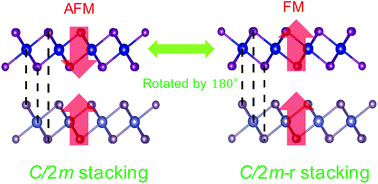Switching interlayer magnetic order in bilayer CrI3 by stacking reversal†
Abstract
CrI3, a hot two-dimensional (2D) magnet, exhibits complex magnetism depending on the number of layers and interlayer stacking patterns. For bilayer CrI3, the interlayer magnetism can be tuned between ferromagnetic (FM) and antiferromagnetic (AFM) order by manipulating the stacking order. However, the stacking is mostly modified through translation between the layers, while the effect of rotation between the layers on the interlayer magnetic order has not yet been fully investigated. Here, we considered three energetically stable stacking patterns R![[3 with combining macron]](https://www.rsc.org/images/entities/char_0033_0304.gif) , C2/m and AA in bilayer CrI3, and their reversed counterparts R
, C2/m and AA in bilayer CrI3, and their reversed counterparts R![[3 with combining macron]](https://www.rsc.org/images/entities/char_0033_0304.gif) -r, C2/m-r and AA-r through rotating one layer by 180° with respect to the other layer. Our first-principles calculations suggest that the interlayer magnetic ground state can be switched from AFM to FM (or FM to AFM) by reversing the stacking pattern. A detailed microscopic analysis was carried out by magnetic force theory calculations on C2/m stacking which favors AFM and C2/m-r stacking which favors FM. The interlayer magnetic interactions and the origin of the magnetic order change were revealed through specific orbital analysis. Our work demonstrates that stacking rotation can also tune the interlayer magnetism of CrI3 and provides insight into its interlayer magnetic properties at the microscopic level.
-r, C2/m-r and AA-r through rotating one layer by 180° with respect to the other layer. Our first-principles calculations suggest that the interlayer magnetic ground state can be switched from AFM to FM (or FM to AFM) by reversing the stacking pattern. A detailed microscopic analysis was carried out by magnetic force theory calculations on C2/m stacking which favors AFM and C2/m-r stacking which favors FM. The interlayer magnetic interactions and the origin of the magnetic order change were revealed through specific orbital analysis. Our work demonstrates that stacking rotation can also tune the interlayer magnetism of CrI3 and provides insight into its interlayer magnetic properties at the microscopic level.

- This article is part of the themed collections: Nanoscale 2022 Lunar New Year Collection and Nanoscale Most Popular 2021 Articles


 Please wait while we load your content...
Please wait while we load your content...